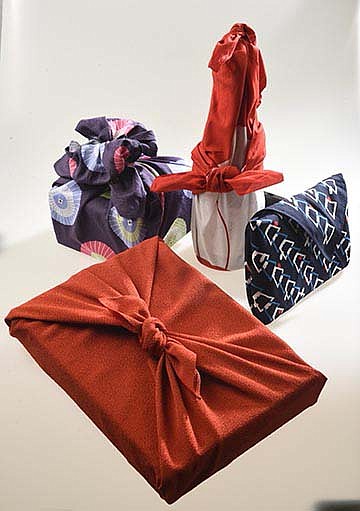Ditch the paper gift wrap, bags and tissue paper this holiday season for the eco-friendly alternative of furoshiki (pronounced fu-row-she-kee). The Japanese wrapping technique is traditionally performed with a singular cloth fashioned around an item in a labor of love for the gift and its recipient.
The ties and knots represent the ties and connections of people, according to "The Furoshiki Handbook," a bilingual guide on the style.
When Margaret Armour, who owns the Japanese-themed boutique I Go Tokyo on the North Shore, left her wallet in Japan on a recent trip, a friend sent it back wrapped. "It was so beautiful, I almost didn't want my wallet back," Armour says of the intricate packaging.
Want to learn?
With the help of Japanese native Itsuko Doi, I Go Tokyo owner Margaret Armour hosts furoshiki classes at the store. The next one is Dec. 14 from noon to 2 p.m. To attend, RSVP on Facebook or Instagram @IGoTokyoStore.
The art of furoshiki can be traced to the Japanese Nara Period, about 1,300 years ago, when people used cloth wraps to store imperial items. Over time, furoshiki became a go-to way to wrap and travel with items.
The name stems from the Japanese word "furo," which means "bath," and "shiki," which means "something to spread out." Back when public baths were popular, guests would transport their clothes in a furoshiki wrap, then use the cloth for a towel or mat.
Popularity fell with the rise of plastics, but with a growing focus on sustainability, the trend has come around again. Common uses in Japan include wrapping a bento box and using the cloth as a placemat, or gifting a wine bottle in a furoshiki fashioned bag.
International Japanese sensation Marie Kondo uses furoshiki when packing her suitcases to maximize space, and as the holidays approach, she advises followers on her website to pick "some fabric squares that spark joy for you and use them furoshiki-style."
"It's renewable, which the Japanese are really into that," Armour says. "It looks different, it's sharp and it holds up."
The cloths come in sizes ranging from 45 centimeters for small items like books, bento boxes or to create a decorative tissue box, up to 150 centimeters for larger items like wine bottles or self-fashioned handbags.
The most important component of the wrap is the knot. The standard, and most common, is the Ma-Musubi knot. This square knot holds the wrap securely around the object, sometimes also becoming a handle used to carry the package.
For more formal occasions in Japan, like a wedding, one would wrap the gift in furoshiki, present the gift to the couple, unwrap it in front of them, then leave the gift and keep the wrap. But I Go Tokyo associate Itsuko Doi, who grew up in Japan, says among friends it's customary to present the cloth as part of the gift.
Armour visits Japan regularly to stock her boutique and has filled the store with goodies and trinkets from the island nation across the sea, including, of course, furoshiki cloths in an array of prints.
The shop, she says, has become a familiar hub for Japanese transplants, creating a family of sorts that includes residents like Chattanooga Symphony and Opera Music Director Kayoko Dan and Chattanooga Football Club player Genki Miyachi.
"We have our own little family here," Armour says.
